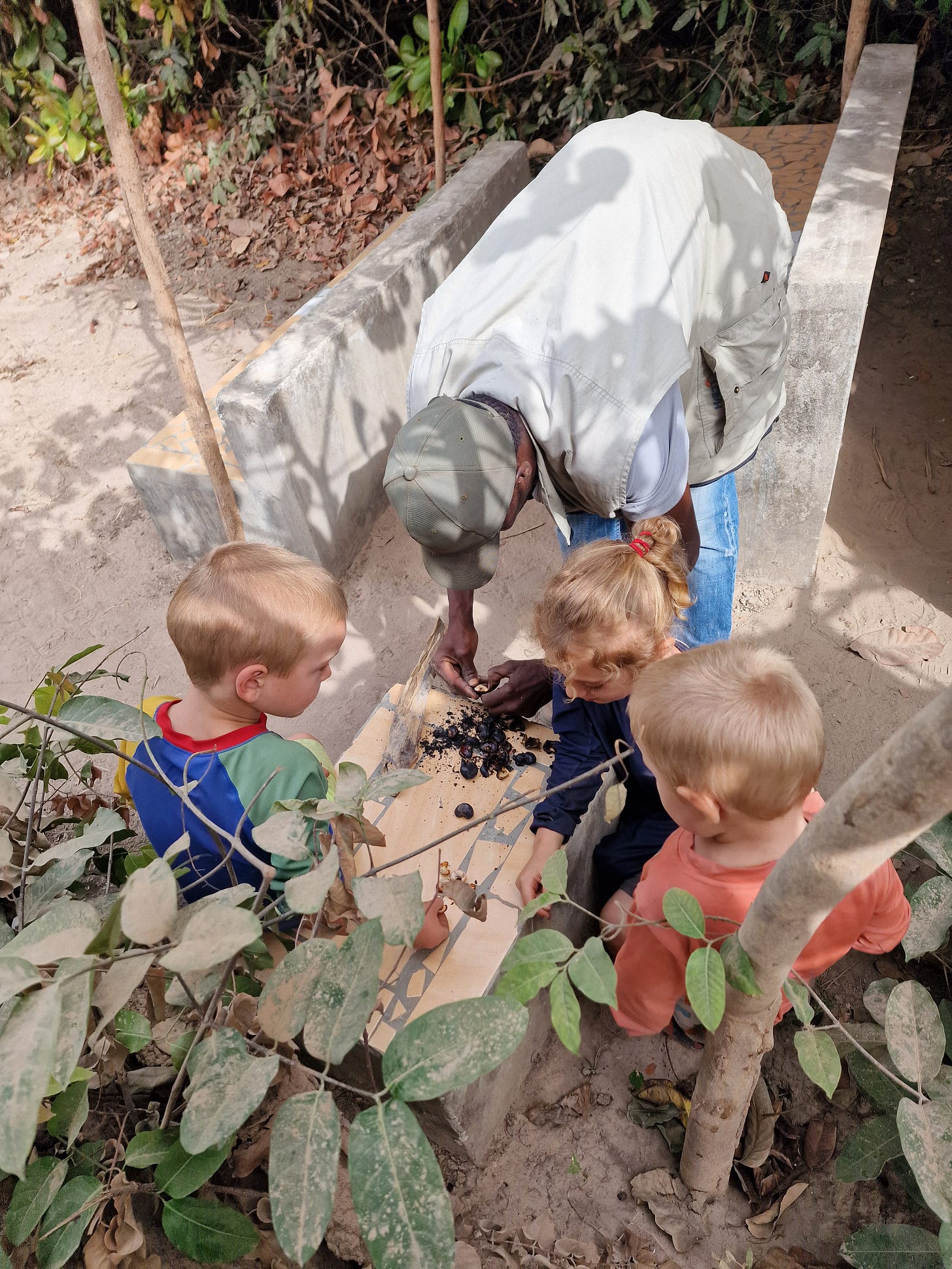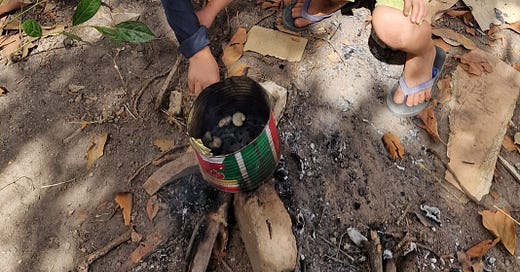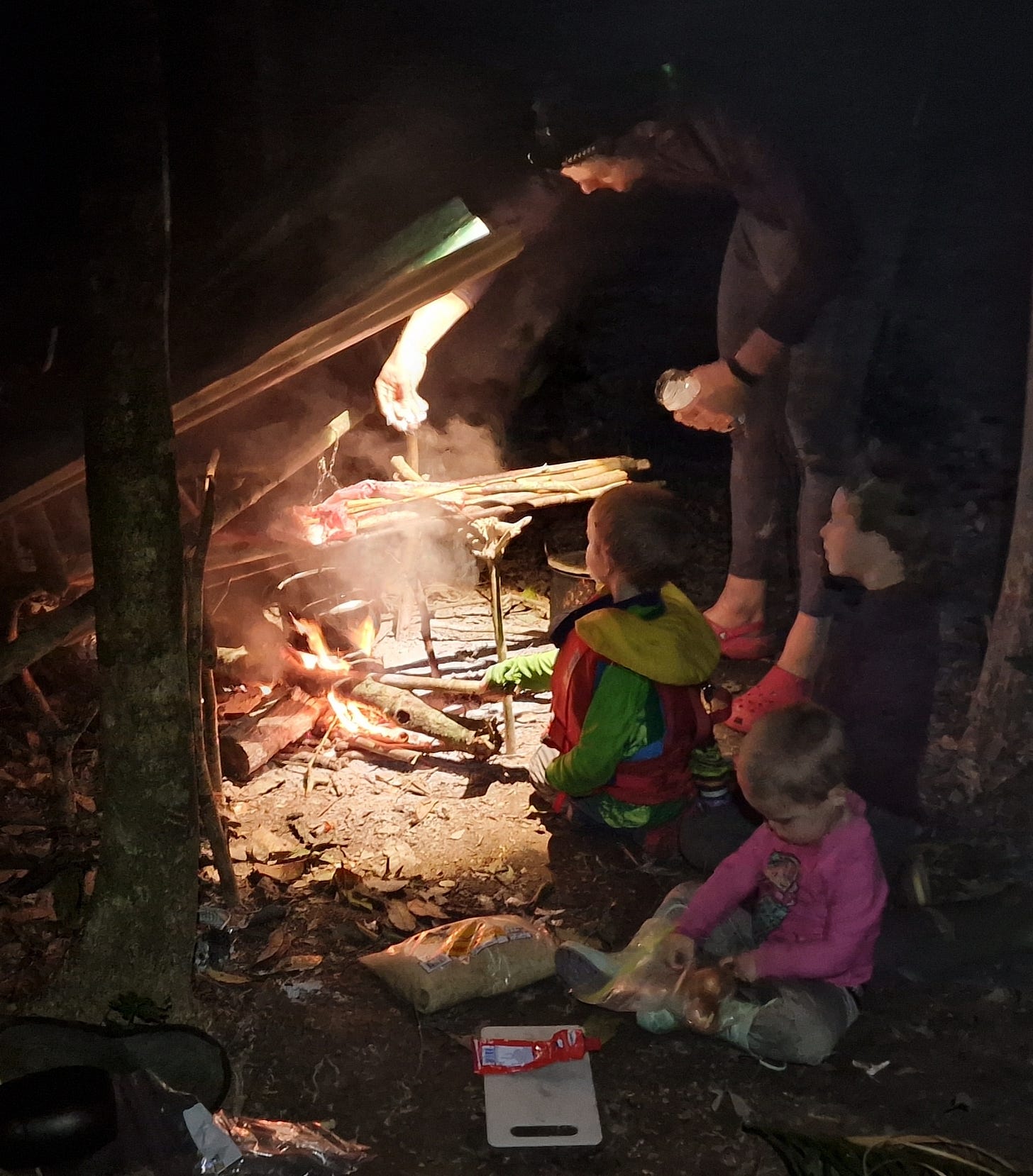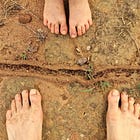How do kitchens exclude children?
Our unwillingness to squat excludes children from adult lives
The first time you see an eight-year-old whip out a lighter and start a fair-sized fire on school grounds, it’s a shock. Once a passing teacher has explained that the country has no system for rubbish collection and this is part of the required activities for the older year groups, you relax a little. A little.
By the second week, however, I’d gotten over the surprise and was really watching. I saw children as young as five and six gathering a pile of rubbish, clearing a safe space free from dry leaves and sticks, setting a fire, and lighting it easily. I watched fires lit, tended, and then extinguished. Even without adult supervision, I saw no tomfoolery or unsafe behaviour. This was serious work. Keeping the school grounds clean was their responsibility, and they took it seriously.
Perhaps I shouldn’t have been so surprised. All kids love fire. Living in the jungle meant cooking over a fire, and within a few weeks our children had worked out how to borrow a burning stick from the cooking fire to make their own “toy fire” to tend. When the rainy season arrived, we made a rain shelter for our fire, and they made a smaller one for theirs. They rapidly learned to respect it, look after it, feed it, and put it out safely when the meal was ready. They did this almost every day for a year and did not get burned.
Sadly, this is not always the case. Fire can kill. However, before I’d seen children around an open fire, I’d not realised the major difference between children’s kitchen burns in the UK and in the jungle. Before we'd left, if you had said that cooking over open fires might be safer for children than cooking on our beautiful glossy induction hob (which can't set clothes alight and doesn't stay hot after use), I’d have laughed. But it didn’t take me long to see the difference.
(NB. There’s a discussion to be had here about open fires and the chronic damage that cooking over a wood fire does to your lungs and whether that needs to be taken into consideration in this equation of safety. However, given that it is irrelevant to my major point, I’m going to not include it from here on. Just bear in mind that, if all else is equal, maybe try not to breathe in smoke?)
The majority of burns (kitchen or otherwise) for toddlers in a WEIRD environment is scalding from hot liquids. 30 children a day in the UK are taken to hospital with scalds. Some of them die. Hot liquids are seriously dangerous. Freshly-made cups of tea, hobs and kettles are the biggest risks, with saucepans on hobs causing some of the worst accidents. That’s why responsible parents are always very careful of children near hobs, right? We make sure that they stay well away, or that we’re right with them, guiding their every move, so they’ll never burn themselves. The Good Food website recommends that children should only start using a hob when they are eight years or older.
But children in traditional communities start to cook much earlier than that. By doing so they catch that early abundance of motivation to learn household activities and grow up with food prep as second nature. But their cooking involves boiling pans of water (and occasionally oil) too. How is it they can do this without being almost instantly scalded to death? What is the difference between an open fire and my glossy new induction hob?
The answer is height. Pans in the UK are at head height for a young child. Pans in traditional communities are only just above floor level. Not only do they pose less of a risk should they spill, but children can clearly see into them and know what to avoid. And that huge increase in safety opens up a whole culinary world to these kids. Once they can get near the cooking, they start to get involved in chopping vegetables, mixing dough, sharpening the knives. They become very proficient cooks very early and set themselves up for a lifetime of healthier diet and more choice (and impressing the pants off their friends). Cooking on the floor democratises food prep.

After more than a year of this, I found myself thinking during my return journey: Why had we ever done it any other way? Why had we put everything at adult-only height and made it so much harder and more dangerous for children to learn to cook? I stared at my own kitchen when I finally got home. And I stared. And I stared. And bent down to get something and it hit me.
Westerners can’t squat. Through a combination of non-stretchy tight clothes, inflexible shoes, and raised toilets, beds, desks, and dining chairs, we’ve taken away every ability and incentive we ever had to get into and hold a squat. And you need to be able to squat to comfortably cook at floor level. Squatting means you are at the right height and angle to work on the floor and you can shift your weight around to do the different tasks that need to be done when cooking. And sure, when you’ve got a long task to do (pounding cassava and plantain into fufu, for example), a low stool gets you where you need to be, but squatting gives you the agile responses you need for the intense part of cooking.
Squatting just isn’t done in our culture. Even the word is laced with negative connotations. But squatting is an essential movement for humans. It describes any of the varied positions in which the weight of the body is through the feet, but the hip and knee joints are fully flexed.
Squatting takes balance, knee health, and leg strength. In return, squatting gives a leg workout, a knee cartilage refresher, improved abdominal and pelvic health (especially if done while toileting), and improved leg and back flexibility. Why doesn’t most of the world get lower back pain and haemorrhoids? That, my friend, would be because they squat.
Around the world, people squat to work, squat to cook, squat to rest, squat to toilet, etc. They squat because sitting is less hygienic and often less comfortable. They squat because they still can: among the many other things it does, squatting maintains your body’s ability to squat. Easy, comfortable squatting is one of those use-it-or-lose-it things. Like using public libraries or the ability to digest milk. Once you stop, you've stopped.

When we started to use chairs more (scarily recently, when I read up on this - chairs only made it into the houses of us commoners around 200 years ago), we stopped squatting. We didn’t spend more time sedentary (sedentary time of the hunter-gatherer Hadza people in Tanzania is comparable to Western sedentary time), but our muscles became much less active during this sedentary time. When we chair-sit rather than squat, we outsource support from our leg muscles to our chairs. Our muscles become weaker and our joints stiffer, and suddenly squatting’s no longer on the table.
And so our love of chairs drove our waist-high kitchen surfaces, our requirement to keep children out of the kitchen while cooking, and it teaches children that food preparation is only for adults. It likely contributes to the high rates of picky eating in children in our culture. It probably even drives the market in fake-food toys. How else do you divert a child’s deep evolutionary motivation to learn how to prepare food?
There’s more (so much more) on the unintentional consequences of our drive for comfort and convenience in my book, Growing Up WEIRD, but let’s have a few ideas for improving things now.
Practise using the floor more during cooking. Identify your barriers and reduce them. Worried about cleanliness? Wipe the bit of the floor before you use it. Keep forgetting? Post-it note reminder. Uncomfortable? Frame it as your new workout for flexibility.
Consider getting a second-hand induction hob that can live on the floor in the corner of your kitchen for your children to use. Often, they’ll cook eggs, mushrooms, or vegetables. Sometimes they’ll fry and eat grass or mosquito larvae. It’s all part of developing cooking skills.
And why stop at cooking? After all, if work-surfaces are the enabler of low-movement cooking, chairs and tables are the enabler of low-movement eating. Picnic-style floor meals are fun!
You may also like:
Prefer a podcast?
References
Hadza sedentary time: https://www.pnas.org/doi/10.1073/pnas.1911868117
Common causes of burns in children: https://www.hopkinsmedicine.org/health/conditions-and-diseases/burns/burns-in-children











Taylorization.
When they studied the workers in factories, they found they worked more efficiently at waist-level, and this was importing into kitchens as counter space.
On the other hand, by the age of eight, I was capable of cooking a meal for my family on the stove.
What's your thoughts on breastfeeding on the floor, especially for fast flows 😂 if I could work this out, we would definitely give this change a go. I've noticed my back is so sore from being on the couch a lot feeding. I'd like to make this change and I know my husband loves changing things up too